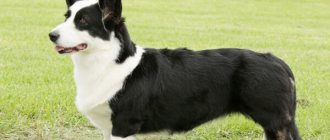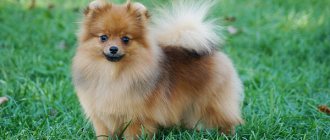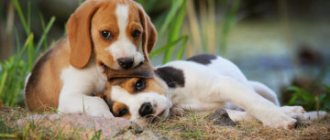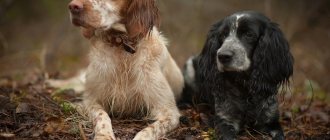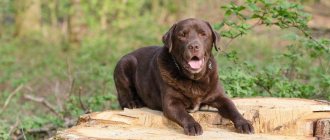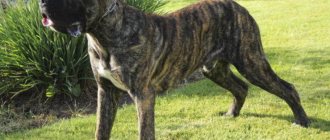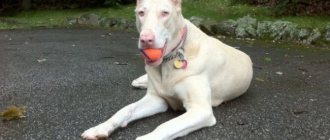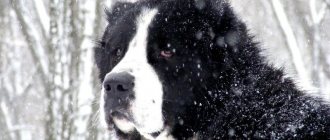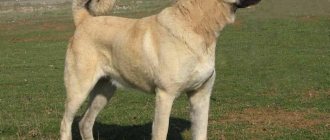When choosing a pet, the future owner gives preference not only to a specific breed. Often people pay attention to the color of the dog. After all, animal fur contains a wide palette of colors and shades that can amaze with their combinations and patterns. The appearance of the dog depends not only on the breed, but also on genetic conditioning.
Color groups
Experts divided all the variety of colors into several main groups. They include both single-color and multi-color variations of shades and patterns.
Solid
The solid color of tetrapods is distinguished by the presence of only one shade on their body. On the other hand, it may be its complete absence. The substance eumelanin forms black or chocolate pigmentation with varying degrees of saturation. The lightened form of this type is called blue or beige.
The substance pheomelanin is responsible for the red or deer variant. And the lightened form of the pigment gives a sandy background with variations from white to light cream.
Mixed
A mixed group appears by combining a pair of shades. Moreover, the white tone should not participate in the mixing. The variation in the colors of the dog is influenced by the presence of the substance eumelanin or pheomelanin. As a result of the manifestation of these two pigments, 5 types of mixed tones are distinguished:
- red with a black mask on the face;
- red with some darkening;
- brindle;
- black with reddish tan;
- red with black undertones.
All types of these variations are characterized by some lightening and a special placement of pigmented fur on the body of the four-legged friend. The mask, in turn, is combined with each of the four tones.
Modified
The mentioned groups may change with age. So, spots, bleached or piebald areas appear on the fur. However, lightened dog coat color is common in many breeds, and this is in no way due to age-related changes. It’s just that a pet is born with pigment, but over time it loses it.
This modification can be observed in combination with any base tone. For example, dark spots or variegated shades are clearly visible against gray and lightened backgrounds. This is the so-called marble tone.
White spots are formed due to a complete lack of pigmentation on certain parts of the pet’s body. There are pets that have white spots located almost all over their body, and only their ears are colored.
Two main types
To facilitate classification, the colors of dogs are usually divided into monochromatic and multi-colored. Each type is divided into several categories.
Single color
Dogs with evenly colored fur are called plain and are divided into several types.
Solid color English Cocker Spaniel puppies
Multicolor
The concept of multicolor includes combinations of different shades, as well as patterns on the dog’s coat. These colors are divided into several types:
Marble color in Chihuahuas
A striking representative of the black-and-white color is the German Shepherd
German brindle boxer
In addition to solid and spotted colors, there are also patterns. A pattern is the coloring of certain areas of the body or the presence of a regular pattern. This could be streaking, scooping or scorch markings.
Single-color dog colors with shade names
Individuals of the same color are found in different breeds. There are quite a lot of them, so they delight you with rich tones and interesting solutions. Specialists in the selection and breeding of four-legged animals have created a classification of individuals with uniformly colored fur.
All monochromatic representatives are divided into:
- Dark
, which are influenced by the substance eumelanin. The saturation of the dog's color depends entirely on the concentration of this pigment. A high content of eumelanin was noted in dark brown and black individuals. Some breeders say that there is no such thing as a black dog, but that it is simply a highly concentrated shade of dark brown.
- Svetlykh
, whose fur was colored with pheomelanin. A high concentration of this element in the hairs of the animal gives them a yellow and deer tint. A slight pigmentation with pheomelanin makes the pet's fur sandy.
- Reds
, which include light reddish and deep red coats. The main tone of this option is red. The mahogany look is now popular, incorporating the brightness and richness of red.
- Apricotsovs
, which are considered just an intermediate step between cream and red options. This species has some degree of whitishness and is distinguished from the red one by inclusions of light hairs.
- Blue
– this option includes silver and gray fur. Individuals with blue fur are distinguished by an ash-light or dark shade.
- Isabellovs
, or weakened brown. This is a pinkish-cream version with gray or blue tints. The variant is obtained by mixing blue and red colors.
- Belykh
individuals who received such a coat at birth. Snow-white pets have black or brown noses and lips.
- Palevykh
, having a lightened red color. The fawn color of dogs can have different shades. Thus, the area of the chest, paws and the lower part of the tail can be almost white, and the mask on the face, on the contrary, is dark or even black. Fawn-colored dogs differ in the tone of their nose: it can be pink, brown or dark.
This classification of monochromatic individuals gradually becomes more complicated, supplemented by other options. So, recently they began to talk about albinos, whose fur looks snow-white. In fact, the fur coat of albinos is colorless, and the lips and nose of the unusual animal are painted white. In nature, there are very few true owners of such wool.
Australian Shepherd
© shutterstock
Originally a herding dog, Australian Shepherds are believed to actually originate from Spain and were bred in the States to become the breed we know today. Also known as Aussies, they are similar in appearance to the Border Collie and English Shepherd breeds and display a stunning tri-colored coat with lush fur. Their coat comes in two tri-color variations - red/white/copper and black/white/copper . However, some puppies do not develop the copper color due to their genetics, which is why they are called bi-colored Aussies . Australian Shepherds are a medium-sized dog that is tough and agile, very intelligent and can run in circles around a timid or less experienced owner.
- Exercise : High energy dogs, the Aussie needs about two hours a day.
- Grooming : Because they shed constantly, they need regular grooming, ideally daily.
- Life expectancy : 12-15 years.
- Ideal for : very active, self-confident owners.
Two-color varieties
The combination of two different shades on the body of a four-legged friend allowed breeders and zoologists to talk about a large number of variations. These include quite common types, and those combinations that are difficult to find on an ordinary dog.
Tan
The main tone of this option is gray, brown or dark. The tan color of dogs is distinguished by light spots that sharply border on the main tone. Tan is located on the eyebrows in the form of two spots, on the cheekbones, throat and chest area. There are lightened areas on the muzzle, but in this case the bridge of the nose has the main pigmentation. Tan marks can be seen on the front of the animal's paws, around the anus, and on the bottom of the tail.
Zonar, or wolf
The zonal or wolf version of the two-color color has a light background. At the same time, in certain areas of the animal’s body, yellow, black and lightened areas are clearly visible.
Cheprachny
The basis of a dog’s saddle fur is a red pigment, which gives the pet’s fur coat different shades - from bright red to light fawn. In addition, black or gray becomes the main tone.
The sable color of dogs differs in size and tone. Most often, darker areas are located on the upper part of the animal’s body: on the head, shoulders, back, tail. Lighter pigmentation occurs on the lower jaw, cheeks, throat, chest, and belly.
Sable
The coat of pets with the sable color variant is characterized by a predominance of a reddish tint of varying degrees of saturation. The ends of the hair of such representatives contain a special pigment that colors them black.
brindle
The brindle color in dogs appears as transverse dark stripes on brown or sandy fur. The body of the animals is painted in warm shades: yellow, red, red. There may be gray fur, but it is very rare.
Sometimes the presence of whitish points is noticeable, which is not considered a flaw. The stripes on the dog's body look like rings that break on the stomach. A dark, almost black mask is often visible on the face of a tiger pet.
Murugiya
This option takes as a basis a dark red shade, which varies, reaching the darkest color of mahogany. The ends of the pet's hair are covered in a dark, almost black tone. The nut color, which is called fawn, is also found here. It can range from light sandy to dark golden in tone. Redness is not typical for this species.
Papillon
© shutterstock
Papillon means butterfly in French, and this tiny, good-natured black, white and brown dog is so named because of the butterfly shape created by its witty feathered ears. The breed is believed to date back to the 16th century and is descended from toy spaniels. Despite his miniature size, the Papillon has a large personality, he is active, intelligent and loves his people. According to the breed standard, their coat is smooth and fine-haired, with a base color of white usually defined by black and brown patches on the face, around the nose and ears.
- Exercise : Two to three 20-minute walks or play sessions per day are ideal.
- Grooming : Brush once or twice a week to keep the coat in excellent condition.
- Life expectancy : 14-16 years.
- Ideal for : Family or fun home owner.
Three-color variations
A tricolor dog acquires its color as a result of a mixture of tan or saddleback species combined with black or red spots. Moreover, the marks are placed in strictly defined areas of the body, and not in a chaotic manner. Among these variations are:
- Roan
, the peculiarity of which is the location between pigmented hairs of non-pigmented (that is, white). This combination creates a silvery background with some weakening.
- Marble
, or "Harlequin", with a white, blue-gray or light base. The dog has black spots with jagged edges. Sometimes the marks may have a brownish-gray tint.
- Piebald
, which is a combination of two bases. This option appears in large light or white spots. They are located on a reddish background. In some cases, the base tone has a different pigment.
The names of colors vary among different breeds. These may be traditional specific names. There are also special names for the colors of hunting animals, which have historically developed and become entrenched in the everyday life of lovers of four-legged animals.
Basenji
“The dog that doesn’t bark” is the second name of this unique breed. The short-haired individual has smooth, well-defined muscles. The height at the withers of an adult dog can reach a maximum of 43 cm. Representatives of the Basenji have: long legs, large erect ears and a tail curled into a ring. The folds on the forehead, which are well pronounced in Basenji puppies, give a special seriousness to the look.
Read Top 20 best guard dogs for protecting a private home
There are only six colors of the Basenji breed. One of the most popular is the brown color with white accents, which can appear on the dog’s belly, paws, tail or face.
Types by location of spots
The appearance and location of the marks on the dog’s body differ in intensity and size. They can cover almost the entire body of the animal or concentrate in certain areas. Dogs with spots on their coats come in most breeds. Based on the location of the spots, they are distinguished:
- Irish spot with white markings of varying sizes that cover most of the animal's body.
- Piebald, in which there are large white areas on the head, neck, chest, tail and paws against a dark background.
- Extreme spotting with a small amount of primary color pigment. Sometimes the pet appears white with small colored areas.
- Speckling, when many small spots are visible on a white or light gray tone, the color of which depends on the main color of the dog.
- Marble with black spots of irregular geometry and different sizes on a white base.
Some breeds begin to develop a spotted pattern as they age. For example, the fur of Dalmatians only after two months of life becomes similar to the standard exterior that is familiar to people. Sometimes the appearance of spotting is associated with deviations from the characteristics of the breed.
Corgi
© shutterstock
Corgis come in two breeds, the Pembroke Welsh and the Cardigan, and despite their shorter stature, both were originally bred as herding dogs. This heritage means that the Corgi is an energetic baby who needs a lot of exercise and stimulation. Their size, temperament and appetite for play also make the Welsh Corgi a super pet for families with children. They are also very intelligent and stubborn, so early and consistent training is required. Both breeds have a lush double coat and come in a variety of colors, including a beautiful tri-color combination of red, sable, black, white and fawn.
- Exercise : Walk for at least one hour a day.
- Grooming : Corgis shed very frequently with their undercoat, so regular grooming is required.
- Life expectancy : 12-13 years.
- Ideal for : families with children.
Varieties of face masks
Different breeds of four-legged animals differ not only in the color of their coat, but also in other features of their exterior. Thus, on the dogs’ faces you can see masks characteristic of the breeds.
They are dark - brown or gray. Masks may vary in size and extend to the chest. The marking is combined with a variety of bases: zoned, saddle, tan and brindle. And among greyhounds the mask is called “mazurina”.
Reverse masks are light areas on the dog's face. May be called domino or grizzly. The reverse mask is combined with zonal and saddle tones.
Dogue de Bordeaux
French breed of large sizes. In the area of the animal's muzzle there are a large number of folds, symmetrically located on both sides. The height of a dog with a constant “sad” expression on its face can reach 68 cm.
Read The best herding dogs - 20 breeds and their uses
The most common color of the Bordeaux breed is brownish chestnut. Great Danes have a thick coat and thin hair. The color of the fur on the ears of animals is darker than on the rest of the body. To maintain the health of your Great Dane's coat, you need to brush your dog with a rubber brush at least 2-4 times a month. It is also recommended to clean the folds on the face with a damp cloth after each meal.
The rarest types and tones of dog colors
There are rare color variants that are found only in some breeds. For example, Blenheim combines the mottled hue of rich chestnut with a pearly white background. This type of coat is typical for Cavalier King Charles Spaniels. This breed has a white diamond-shaped pattern on the crown of their head.
Pit bulls, bull terriers, corgis, Aussies and other breeds have a rare type of color called merle. This is uneven pigmentation of the coat. Merle appears as a combination of the same dark or light background.
Merle is rare, since the gene responsible for this coloring carries deviations in health. It is prohibited for breeding in most breeds.
Chow chow
Made in China. A powerful animal with a harmoniously built body, the height of which can reach a maximum of 56 cm. The most striking feature, in addition to the fluffy thick fur, is their blue tongue.
Brown Chow Chows are more difficult to describe than other colors. The color of the coat varies from sand with a gray tint to brown with a coffee tint. On top, the brown fur gives a reflection of matte silver. The hair never shows stains. The cover is a single color. The Chow Chow's muzzle is covered with a mixture of light and dark hairs. The eyes of the Chow Chow breed of this color are brown.
Read TOP 20 kindest dogs in the world
Your pet's thick coat requires constant care on a daily basis.
Genetic conditioning
The appearance of the fur of tetrapods is determined by different genes. Some of them are responsible for the fusion of the substances eumelanin and pheomelanin. Other genes distribute these elements throughout the pet's coat and body.
There is a hereditary predisposition that determines the intensity of the basic tone and spottiness of the fur. The main genes responsible for the tone of the coat are genes A, C, B, D, E, G, M.
Their combination forms the color and pattern on the body of the four-legged friend. Genes are able to combine in different combinations, distributing pigment and spotting throughout the body. Experienced breeders, having seen the parents of the future puppy, are able to calculate the baby’s exterior, even if he is still in the womb.
The standards of some breeds contain strict rules on genetic conditioning. For example, in Europe there is a ban on dogs with Isabella color. This variant contains a combination of genes that subsequently provoke a whole range of diseases.
Stains
Notification. An unusual color is usually referred to as a color that falls outside the breed standard. These can be either regular standard or unexpected and funny coloring pages. Dogs with these characteristics make good pets, but should be excluded from breeding.
The presence of spots is typical for many breeds. Dalmatians and German dogs immediately come to mind. The spots are dark and white. A separate gene is responsible for the inheritance of marbled coloration. Dark spots can be any color available in the dog's genotype.
How coat color changes with age
Experienced owners and breeders know that the appearance of some pets' coats changes over time. For example, if a puppy was born brown, then the tone darkens with age.
Sometimes these changes are indicated by the nose. If it is darker than the main background of the coat, then over time the fur will become darker. Owners of the following breeds experience similar discoloration:
- Rottweilers acquire a bright tan color as they age. Sometimes black specks become noticeable.
- German Shepherds are born tan but become black over time.
- Dalmatians are born completely white, and from 2 weeks they begin to acquire spots. By two months, the Dalmatian turns into a dog with black spots.
- Kerry Blue Terriers initially have a black coat, but after a while the silver pigment appears.
In addition to the listed breeds, changes occur in the exterior of the Yorkshire Terrier, Bobtail, and Spitz. Sometimes an unexpected pigment change occurs. Such changes do not affect the loss of characteristic breed standards, because they are provided for during the breeding and further sale of grown-up puppies.
Also, one cannot discount the simple gray hair that appears in older individuals. Due to it, the color is slightly lightened, and sometimes reaches a piebald shade.
In general, the dog’s appearance is influenced by the genetic predisposition of the breed, as well as the mixing of the colors of the parents. Over time, your pet's appearance changes due to age or characteristics.
Dogs can surprise with their colors, thereby winning the hearts of fans. However, everyone should know that dog colors are classified into groups, each of which has different characteristics.
Age changes
To determine whether coat color will change with age, breeders will use simple methods to identify overcoloration. For example, a brown puppy may darken as it gets older. Your nose will help predict this transformation. If a light brown puppy has a dark nose, his color will darken over time.
Unusual colors of dogs
Someone born black can suddenly become rich. Such changes can be determined by the color of the undercoat. If you move the curls apart, a brown tint will be noticeable at the base of the hair.
A brown puppy may become darker as it gets older.
Breeds that change color most often:
Types of Doberman colors
Attention! Color modifications often occur unpredictably. To protect themselves from losing the conformation necessary for breeding the breed, breeders prefer to buy an already adult dog.
The color of a dog's coat is not only its appearance, but also its character. The owner needs to know what a particular shade of pet’s fur will bring him. Whether it will be an excellent hunter or a mischievous friend, the genes of the pet will tell.
Source
Genetics
Breeders have long studied the process by which color and pattern are formed on the coat of an animal. Coloring depends on genes, including those responsible for the pigment and structure of the hair. If mixing occurs, the genes begin to form the color of the dog.
There are several coloring genes.
- C. It is a key component in the entire gene chain. Due to it, the body is able to synthesize all color options. The peculiarity of this component is that it has no color. If it is not present in the body, the puppy may be born with an albino coat. However, even if there is no such gene, the nasal mirror and iris can still become pigmented.
- A. Responsible for the distribution of color throughout the coat. With its help you can get a solid color or sable.
- Q. This is a black gene that dyes hair a dark tone. A breed such as the Giant Schnauzer or Newfoundland must have it. Other types of breeds may have inclusions of such a gene, which will manifest itself as tan or zoned colors.
- D. It is responsible for the richness of the black color. If the gene is weakened, the coat will be lighter, resulting in the animal having a blue pigment. This may affect the dog's vitality. If a baby Toy Terrier or Doberman is born with the recessive D gene, he will receive blue pigment and in most cases will not live to old age. If the gene is dominant, the coat turns out dark and provokes the correct form of melanocytes (pigment cells).
- E. It harmoniously arranges the pigment of black, brown and yellow. With its help you can get solid colors or tri-colors.
- G. It is called gray because it helps lighten the coat as the animal begins to age. Often a dog can be born blue, evenly changing the color of the coat.
- M. This is a marble color. He gives not only the famous harlequin drawing. In its homozygous form, the gene can lead to a congenital anomaly of the fetus. Often a gene can be classified as a modified color because it can also become lighter as it ages.
Color groups
The colors of the animal are divided into two large categories. The first contains single-color variations of colors. The second is divided into two subcategories: two-color and multi-color. Such animals can be painted in colors consisting of two or more pigments.
Solid
Solid color is characterized by the presence of only one color or its complete absence. Due to eumelanin, black and chocolate colors with varying saturation are obtained. In its bleached form, this color is blue and beige.
Due to pheomelanin, a red, deer color is obtained. The bleached form of this pigment produces a sandy coat that can vary from white to cream in color.
Mixed
This color appears due to the mixing of two colors and the absence of white. Depending on the presence of eumelanin and pheomelanin, there are 5 main types of colors:
- redhead, equipped with a black mask;
- red with darkening;
- brindle;
- black with red tan;
- red and black.
Variants of the main color varieties are characterized by lightening and the arrangement of pigmented hairs along the body of the animal. The mask can be combined with any of four colors.
A red color with darkening appears if there are two pigments in the coat, forming a black (brown) and a red pigment (it is called zonal). Due to this, the pigmentation zone can be distributed differently. There are a variety of options:
- if there is alternation of pigment in the hairs, the color will be wolf;
- if the black pigment is located at the end of the hairs, the dog receives a sable color;
- when dark zones in the form of vertical hairs form on the body of the animal, a brindle color is obtained;
- a black pigment located on the muzzle, the front area of the head (which reaches the ears), is called a mask;
- black hair located on the back and descending to the lateral and femoral areas is called saddle color.
Tan spots are red-colored spots with clear edges. They can be located in certain areas on the animal’s body. The lightened version will be accompanied by a change in shades.
Modified
Solid or mixed color can change due to age-related changes. It manifests itself in lightening, spotting and piebaldness. Lightened colors are accepted in different breeds. This is not associated with the aging process and is characteristic of the Beglinton Terrier. A puppy of this breed is born colored and fades over time. A similar modification can be seen in combination with any base color. Spotted, variegated colors are dark spots that vary in shape. They are located on a lightened or gray background. Marble color is located in this category.
White spots are possible (characterized by the complete absence of pigment in certain areas of the animal’s body), the frequency of which can be small, moderate and widespread. The formation of such spots depends on a certain process, according to which the first spots will appear at the primary sites of depigmentation. The color stays in the pigment center for the longest time.
Sometimes it happens that white spots are located almost over the entire surface of the body and only the tips of the ears are subject to painting.
Varieties
There are only so many original pigments available. Agouti is a series of alleles that is responsible for determining the animal's primary color. In dogs, this color is called zonal gray. An allele is a different form of the same gene:
- the original agouti is a wolf gray color;
- black solid;
- saddle cloth;
- dominant yellow or red.
Agouti is characteristic of wild dogs and many breeds, which are characterized by a zone-gray color. These include huskies, Norwegian Elkhound, and northern sled dogs. Due to genetic mutations, two dominant agoutis appeared - solid black and red, along with two recessive ones - saddle and black and tan. All other colors are the result of mutation.
Single color
There are dogs of different colors.
- Black. They may have a small white spot on the chest area. It is so small that the size can be only a few hairs. An extreme degree of saddle cloth or brindle coloring is allowed. The animal must have a black nose, dark brown lips and eyes.
- Brown. These include liver, coffee (chocolate) colors. They are considered quite complex when it comes to breeding. This color manifests itself if the dog does not have the black gene. This affects not only the hair, but also the eyes and nose. The disadvantages of brown color include fading of the coat under the influence of sunlight.
- Red. This includes rich red shades and light red ones. The main color component is red. The most fashionable color is mahogany, which is distinguished by the brightness and richness of red. The Irish Setter is an example of this color pattern. Dog breeders consider the color to be independent, but in the pedigree it is written as red. The second name for the red color is red. The name is not entirely correct, since the red color combines deer and red. And red, unlike deer color, does not have transitions and lightened zones.
- Apricot. This is an intermediate color, located between red and cream. It is rarely seen in official documentation, although some dog breeds described in pedigrees as cream and red can be described as apricot. The difference from red lies in a certain degree of whitishness and the presence of inclusions in the form of light-colored wool.
- Blue. This may include silver or gray color. Zoned gray along with light brindle may also appear blue if the cch gene combination is present. The color has a mousey, ashy light or dark, wet asphalt, blue tone.
- White. True white dogs have this color at birth. The nose or lips may be black or brown. If an animal is a carrier of the cch gene, at birth they are characterized by a red or fawn color. With age they become lighter.
- Pale yellow. This is a bleached red color. It can also have different shades. The area of the chest, limbs and lower part of the tail is almost white, and the mask can be dark or black. Depending on the B allele in the fawn coat, the color of the nose may vary. Available in pink, brown or black pigment.
Two-color
The following variations are provided in two-tone colors.
Cheprachny
The main pigment is red. Different shades of this color are allowed: bright red, light fawn. Also, the main tone is black, gray saddle cloth, which will be located on the upper part of the animal’s body: head, bridge of the nose, forehead, neck, ears, back, shoulders, hips and the upper half of the tail. The lower part of the body - the lower jaw, lower part of the head, cheeks, throat, chest, belly and bottom of the tail may have light pigment.
The saddle cloth may vary in size and tone. It starts from the neck, and the head can be light. There are individuals in which the saddle cover covers only the top of the shoulders and hips or goes down to the limbs. The saddle cloth can have a gray, black, or brown color. There are clear outlines of light or dark fur, or the color evenly blends into the overall tone. The saddlecloth fully manifests itself after the puppy's coat is replaced.
As a rule, babies are born black and tan. As the animal matures, the fur on the paws, sides and head acquires a light shade.
Tan
The main pigment can be black, brown, gray. The scorch marks will be light. Compared to the main color, it acts as markings that have a permanent pattern.
Tan sharply borders on the main color. It is located in two spots on the body: on the eyebrows, muzzle (excluding the bridge of the nose), chest (appears in the form of two triangle spots, the tops of which look at each other), cheekbones and throat. The tan can be located on the forelimbs and hind limbs, covering only the front part. The insides of all paws are also marked with a tan mark, which creates spots around the anus and the underside of the tail.
Murugiya
Murugii is a dark red color that can vary to a mahogany tone. The tips of the fur have a black or dark pigment. The deer color has a second name - nutty. Can vary from golden to sandy. Redness is not inherent in this color.
Sable
The fur is red in color with black tips.
Tricolor
- Roan. The peculiarity of this color is that between certain colored hairs there are white hairs. Due to this, a silvery color with weakening is formed.
- Marbled dogs are called "Harlequin". The base is white, blue-gray or light. Spots with torn edges of black or brown-gray are regularly scattered on it.
- Piebald. This is a two-color color that is created by large spots of white located on a red background. The background may also have a different pigment.
Unusual shades
There are rare colors that are unique to some breeds. Blenheim is a rich chestnut color stain. They are arranged on a base of pearly white color. The color is found only in the Cavalier King Charles Spaniel. There should be a white diamond on the parietal part, and a chestnut-colored spot in the central part.
Merle is an uneven coat color. Appears in dark or light tones of the same color. This color is found in pit bulls.
